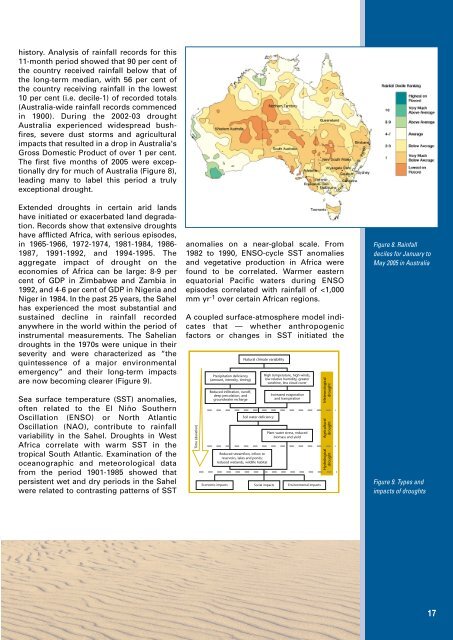Climate and Land Degradation - WMO
Climate and Land Degradation - WMO
Climate and Land Degradation - WMO
You also want an ePaper? Increase the reach of your titles
YUMPU automatically turns print PDFs into web optimized ePapers that Google loves.
history. Analysis of rainfall records for this<br />
11-month period showed that 90 per cent of<br />
the country received rainfall below that of<br />
the long-term median, with 56 per cent of<br />
the country receiving rainfall in the lowest<br />
10 per cent (i.e. decile-1) of recorded totals<br />
(Australia-wide rainfall records commenced<br />
in 1900). During the 2002-03 drought<br />
Australia experienced widespread bushfires,<br />
severe dust storms <strong>and</strong> agricultural<br />
impacts that resulted in a drop in Australia's<br />
Gross Domestic Product of over 1 per cent.<br />
The first five months of 2005 were exceptionally<br />
dry for much of Australia (Figure 8),<br />
leading many to label this period a truly<br />
exceptional drought.<br />
Extended droughts in certain arid l<strong>and</strong>s<br />
have initiated or exacerbated l<strong>and</strong> degradation.<br />
Records show that extensive droughts<br />
have afflicted Africa, with serious episodes,<br />
in 1965-1966, 1972-1974, 1981-1984, 1986-<br />
1987, 1991-1992, <strong>and</strong> 1994-1995. The<br />
aggregate impact of drought on the<br />
economies of Africa can be large: 8-9 per<br />
cent of GDP in Zimbabwe <strong>and</strong> Zambia in<br />
1992, <strong>and</strong> 4-6 per cent of GDP in Nigeria <strong>and</strong><br />
Niger in 1984. In the past 25 years, the Sahel<br />
has experienced the most substantial <strong>and</strong><br />
sustained decline in rainfall recorded<br />
anywhere in the world within the period of<br />
instrumental measurements. The Sahelian<br />
droughts in the 1970s were unique in their<br />
severity <strong>and</strong> were characterized as “the<br />
quintessence of a major environmental<br />
emergency” <strong>and</strong> their long-term impacts<br />
are now becoming clearer (Figure 9).<br />
Sea surface temperature (SST) anomalies,<br />
often related to the El Niño Southern<br />
Oscillation (ENSO) or North Atlantic<br />
Oscillation (NAO), contribute to rainfall<br />
variability in the Sahel. Droughts in West<br />
Africa correlate with warm SST in the<br />
tropical South Atlantic. Examination of the<br />
oceanographic <strong>and</strong> meteorological data<br />
from the period 1901-1985 showed that<br />
persistent wet <strong>and</strong> dry periods in the Sahel<br />
were related to contrasting patterns of SST<br />
anomalies on a near-global scale. From<br />
1982 to 1990, ENSO-cycle SST anomalies<br />
<strong>and</strong> vegetative production in Africa were<br />
found to be correlated. Warmer eastern<br />
equatorial Pacific waters during ENSO<br />
episodes correlated with rainfall of












![View full document [PDF 988.55 KB] - PreventionWeb](https://img.yumpu.com/47733942/1/184x260/view-full-document-pdf-98855-kb-preventionweb.jpg?quality=85)
![View full document (in French) [PDF 4.96 MB] - PreventionWeb](https://img.yumpu.com/47223870/1/184x260/view-full-document-in-french-pdf-496-mb-preventionweb.jpg?quality=85)


![View full document [PDF 25.02 MB] - PreventionWeb](https://img.yumpu.com/44204570/1/190x234/view-full-document-pdf-2502-mb-preventionweb.jpg?quality=85)
